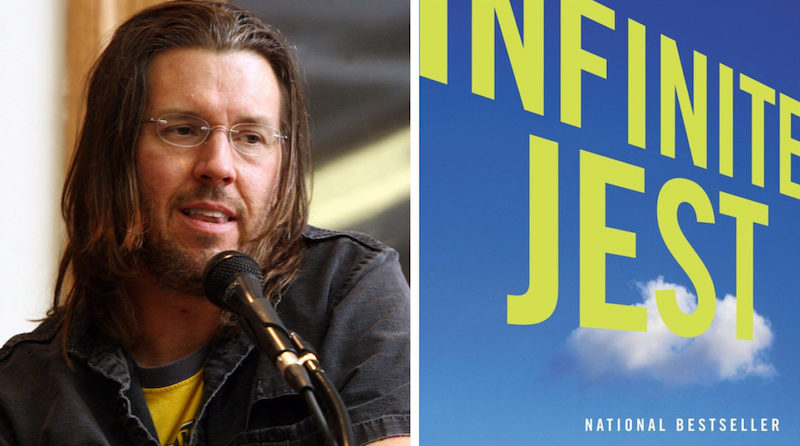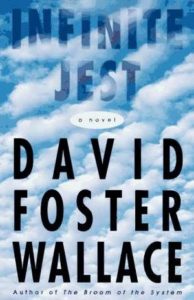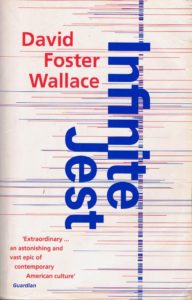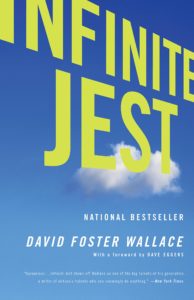

“Everybody is identical in their secret unspoken belief that way deep down they are different from everyone else.”
*
“If nothing else, the success of Infinite Jest is proof that the Great American Hype Machine can still work wonders, in terms of sales. The novel has moved some 60,000 copies and racked up a stack of glowing reviews as thick as it is. What makes the book’s success even more noteworthy is that it is, in a word, terrible. Other words I might use include bloated, boring, gratuitous, and—perhaps especially—uncontrolled. I would, in fact, go so far as to say that Infinite Jest is one of the very few novels for which the phrase ‘not worth the paper it’s written on’ has real meaning in at least an ecological sense; but to resort to such hyperbole would be to fall into the rut that characterises many reviews of this novel.
As the preceding paragraph should make clear, I found Infinite Jest immensely unsatisfactory. I resent the five weeks of my life I gave over to it; I resent every endlessly over-elaborated gag in the book, like the ten-page riff on why video telephones are unviable, or the dozen pages on the teenager who won all his tennis games by playing with a pistol held to his head, or the thousands and thousands and thousands of words devoted to pharmaceutical trivia on all sorts of mind-altering drugs; and I resent especially the 96 pages of tinily typed and deliberately pointless endnotes and ‘errata,’ 388 in total, which make the novel a two-bookmark experience.”
–Dale Peck, The London Review of Books, July 18, 1996
*

“While reading William Gass’s The Tunnel last year at this time, I feared I was witnessing the last of a dying breed, the encyclopedic American novel that began with Gaddis’s Recognitions in 1955, hit its stride in the sixties and seventies (Giles Goat-Boy, Gravity’s Rainbow, Gaddis again with J R, The Public Burning), went baroque in the eighties (Darconville’s Cat, Take Five, Women and Men, You Bright and Risen Angels), then raged against the dying of the light in the nineties with Powers’s Gold-Bug Variations and Gass’s massive masterpiece. Who was left to write such novels, or to read them at a time when some scorn such books as elitist, testosterone-fueled acts of male imperialism? For those of us who regard these works as our cultural milestones, not as tombstones in patriarchy’s graveyard, David Foster Wallace demonstrates that the encyclopedic novel is still alive and kickin’ it.
As with The Tunnel, sheer style is the first attraction of Infinite Jest. Even in his precocious first novel, The Broom of the System (1987), Wallace was unfurling long, complex sentences, by turns sonorous and satirical, that were a joy to behold. Infinite Jest displays a wider range of styles—from the subliterate monologue of a poverty-stricken abused woman to technical explications of the properties of various pharmaceuticals—but the main narrative style is both casual and complex, slangy and erudite, a kind of slacker mandarin with comically manic specificity of detail. Even if you have trouble following the multiplex narrative at the macro level Wallace offers huge entertainment value at the micro level, flaunting (but in a good way) an amazing command of late-twentieth-century English, with its proliferating technical terms, street slang, and babble of late capitalism. Only Gaddis and Pynchon have this range, and Wallace takes the language places even those two don’t go.
…
Addiction struck William S. Burroughs at midcentury as an encompassing metaphor for many facets of American life, and at century’s end Wallace finds a similar metaphor in the recovery from addiction. While Burroughs dwelled with sadistic glee on the horrors of addiction, Wallace takes on the horrors of withdrawal; addiction in Burroughs was largely a response to the need to conform in the Eisenhower fifties, while in Wallace addiction is a response to stress, to the need to excel in the Reagan eighties (the novel’s ‘ethical’ setting, if not its historical one). Again like Burroughs—who is named in the text and seems a pretty clear influence—Wallace uses insect imagery to heighten the repugnance of addiction and detoxification. Infinite Jest is a Naked Lunch for the nineties.
But there’s more: tennis as a metaphysical activity; a hundred pages of endnotes, some with their own footnotes; a parody of an annotated filmography; mindbending excursions into game theory; a Workers’ Comp claim worthy of a Roadrunner cartoon; an essay-length explanation of why video-phones are doomed to fail; and some incredibly sad stories of damaged human beings with more problems than you’ll ever have. The novel is so brilliant you need sunglasses to read it, but it has a heart as well as a brain. Infinite Jest is both a tragicomic epic and a profound study of the postmodern condition.”
–Steven Moore, The Review of Contemporary Fiction, March 22, 1996
*

“Infinite Jest, the title of David Foster Wallace’s gargantuan new novel, is a kind of inside joke. It refers, plotwise that is, to an object much sought after by terrorists: a movie reputed to be so entertaining, so lethally perfect, that it causes anyone who so much as looks at it to become comatose and, literally, to die of pleasure. ‘Infinite Jest’ the movie is the final opus of an ‘apres-garde’ film maker with a profoundly ironic sense of humor.
As for Infinite Jest the novel, it, too, is the work of an experimental artist, and it, too, is often compulsively entertaining, though hardly in any lethal sense. It won’t kill you, though its sheer length and readability might give you eyestrain and a stiff neck. It also shows off the 33-year-old Mr. Wallace as one of the big talents of his generation, a writer of virtuosic talents who can seemingly do anything, someone who can write funny, write sad, write serious, write satiric, a writer who’s equally adept at the Pynchonesque epic and the Nicolson Bakeresque minute, a pushing-the-envelope postmodernist who’s also able to create flesh-and-blood characters and genuinely moving scenes.
Perfect, however, Infinite Jest is not: this 1,079-page novel is a ‘loose baggy monster,’ to use Henry James’s words, a vast, encyclopedic compendium of whatever seems to have crossed Mr. Wallace’s mind. It’s Thomas Wolfe without Maxwell Perkins, done in the hallucinogenic style of Terry Gilliam and Ralph Steadman. The book seems to have been written and edited (or not edited) on the principle that bigger is better, more means more important, and this results in a big psychedelic jumble of characters, anecdotes, jokes, soliloquies, reminiscences and footnotes, uproarious and mind-boggling, but also arbitrary and self-indulgent.
…
“As the reader plows through Infinite Jest, it becomes clear that the subplots involving Gately, Hal and the Canadian terrorists also provide a flimsy armature on which Mr. Wallace can drape his ever-proliferating observations and musings. Indeed, the whole novel often seems like an excuse for Mr. Wallace to simply show off his remarkable skills as a writer and empty the contents of his restless mind.
…
“All these characters are tossed out by the word machine that Mr. Wallace has assembled here, their grotesque, willfully bizarre lives somehow rendered palpable, funny and affecting.
At the end, that word machine is simply turned off, leaving the reader—at least the old-fashioned reader who harbors the vaguest expectations of narrative connections and beginnings, middles and ends—suspended in midair and reeling from the random muchness of detail and incident that is Infinite Jest.
Somewhere in the mess, the reader suspects, are the outlines of a splendid novel, but as it stands the book feels like one of those unfinished Michelangelo sculptures: you can see a godly creature trying to fight its way out of the marble, but it’s stuck there, half excavated, unable to break completely free.”
–Michiko Kakutani, The New York Times, February 13, 1996

